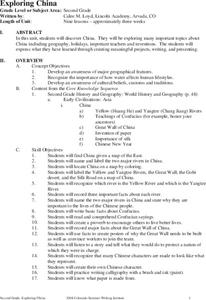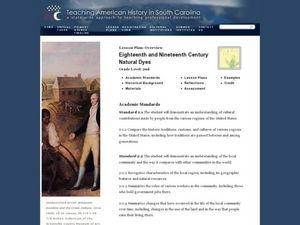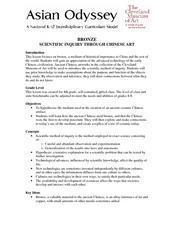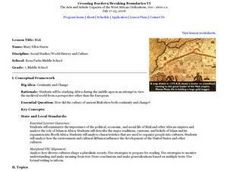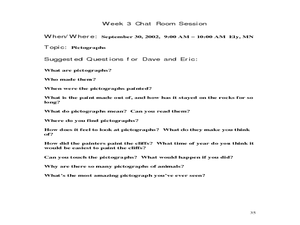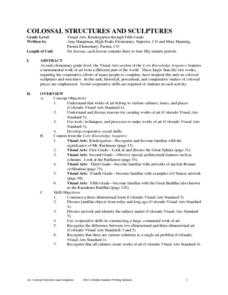Curated OER
The Year of the Rabbit
Students explore a portion of the Chinese Zodiac with projects centered around the year of the rabbit. Students research types of rabbits, actual and fictional. Working in groups, they create a written or multimedia presentation.
Curated OER
Cloudy Days are for Reading and Writing
Students research weather proverbs and determine the scientific validity of 3 weather proverbs. They write an essay presenting their reasoning. They interview elderly people to graph the most frequently heard proverbs and theorize...
Curated OER
Exploring China
Second graders explore the geography, holidays, important teachers, and inventions from China in the nine lessons of this unit. The results of their inquiries are expressed through a variety of products, writings, and presentations.
Curated OER
Eighteenth and Nineteenth Century Natural Dyes
Second graders explore the work of Americans when it came to coloring materials. For this interdisciplinary lesson, 2nd graders follow the provided steps to make natural goldenrod dye from scratch.
Curated OER
Egypt's Greatest Leaders
Young scholars study about seven of Egypt's most famous pharaohs. They discuss leadership styles and draw conclusions about the success of each of these pharaohs. They, in groups, create a project about a pharaoh they studied.
Curated OER
Medicine, Technology and Society
Students compare and contrast traditional Chinese and contemporary Western approaches to medicine. They bring a rational and scientific approach to the evaluation of alternative medicines. They study acupuncture from a Chinese and...
Curated OER
Literature: Isabel Allende
Students watch and respond to a Bill Moyers Now video on the Chilean author, Isabel Allende. They brainstorm a list of recent events that might inspire writers and choose one to write about in poetic, diary, or short story form.
Curated OER
Time Line of Astronomy Events and Discoveries
Students work in groups to present a segment of a timeline of events and discoveries in astronomy. In this astronomy lesson plan, students teach their classmates about their section of the timeline.
Curated OER
Poet Naomi Shihab Nye
Students read and analyze poetry by Naomi Shihab Nye. They define stereotypes, view and discuss a video interview with Nye, present an oral reading of a poem, and write a persuasive letter to an author.
Curated OER
POWERFUL POTATO
Students will observe the growth process of a potato plant.Plant a potato in a large clay pot or gallon bucket. You may purchase seed potatoes
from a seed outlet in early spring or use a potato from home that has started to sprout. Make...
Curated OER
Make Your Own Petroglyph!
Learners create their own petroglyph. In this petroglyph instructional activity, students study and compare various petroglyphs. They create their own petroglyph to symbolize the seasons.
Curated OER
Bronze: Scientific Inquiry through Chinese Art
Students examine the use of bronze and porcelain in Chinese art and commerce through in-class activities, role play events, and small-group discussions in this exciting Social Studies/Arts lesson.
Curated OER
Mali
Seventh graders begin the lesson plan by reading primary sources about the country of Mali. Using maps drawn in the past, they discuss what they can gather about the country from the map and how it has changed over time. They use a...
Curated OER
The Art of the Quilt
Students examine why fabric was first sewn in layers and how it was used. They identify, compare and make 3 different fabric design types which will become a basis for looking at the quilts created by African Americans. They begin the...
Curated OER
What's Right and Wrong? Moral Messages in Art
Students explore the Steen and Mount paintings and their presentation of moral issues. They discuss ethical debates in society today and write a short position paper on an issue raised by the paintings or in the discussion. They make a...
Curated OER
Comparing Sparta and Athens
Students are taught the differences between totalitarianism and democracy. They discuss the historical roots of the democratic tradition. Students are introduced to the term totalitarianism and are told that it is a form of government...
Curated OER
Mummy Tales
Students research types of mummification. In this burial customs lesson, students work in groups to research different types of mummies and present their research to the class. Students compare and contrast the types of mummification.
Curated OER
Applications of Cargoes from Three Continents to the Latin Classroom
Students discuss the importance of communication and writing in their daily lives. In groups, they use the internet to research the development of letters, alphabets and writing materials. They trace the spread of the Latin language...
Curated OER
Ojibwa Arts
Young scholars create a poem based on the Native American Ojibwa art that they read about. In this Ojibwa art lesson plan, students read captions and look at pictures of Ojibwa art and then make up a poem based on them.
Curated OER
Was Alexander Truly Great?
Students discuss Alexander the Great and his father Philip II. They complete the worksheet, Things That Alexander Inherited, discuss Alexander's accomplishments, and write an essay examining whether Alexander was truly great.
Curated OER
Colossal Structures and Sculptures
Fifth graders explore the historical, procedural, and comparative studies of colossal sculptures and structures in this six lessons unit. The cooperative efforts of many people to complete the works is emphasized.
Curated OER
Local and Global Sustainability Unit
High schoolers examine the characteristics that define a sustainable community at the local and global level. They create and prioritize a list of traits, read and discuss a magazine article, and create a poster.
Curated OER
El Favor De Los Santos
Learners prepare to take a field trip to a museum focusing on El Favor De Los Santos. Individually, they develop a symbol based on a piece of art they have been shown. In groups, they write about their trip to the museum and share...
Curated OER
Make a Paper Mache Bowl
Students create a paper mache bowl. In this paper mache lesson plan, students use wallpaper paste, newspapers, and paint brushes to construct a paper mache bowl. Students decorate their bowl with unique designs.




